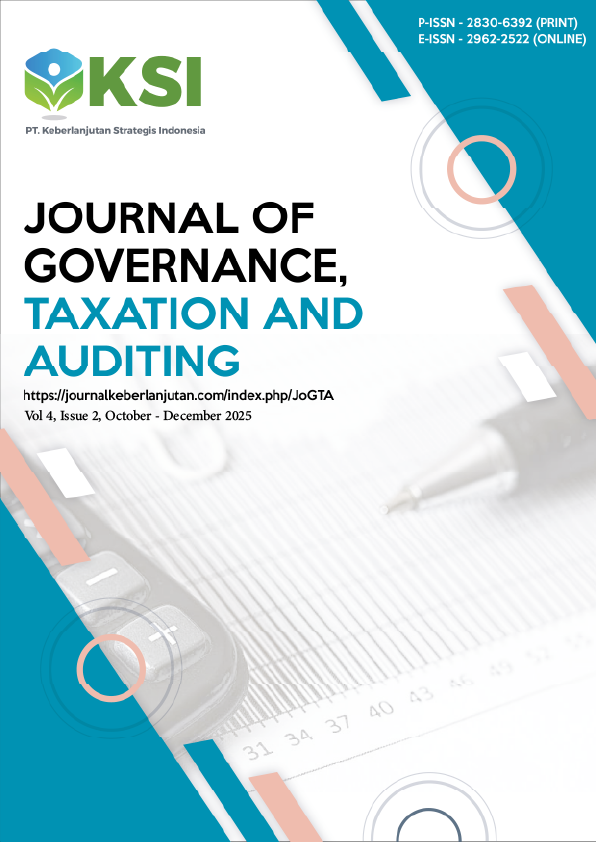Public Service Innovation Through E-Government: A Case Study of the Bandung District Court, Class 1a Special
DOI:
https://doi.org/10.38142/jogta.v4i2.1611Keywords:
Public Service Innovation, e-Government, SIPP, e-Court, PTSP Online, SIWAS, SWOT, TOWSAbstract
Digital transformation in the judicial sector represents a key aspect of e-Government implementation, aimed at enhancing the effectiveness, transparency, and accountability of public services. The Supreme Court of the Republic of Indonesia has developed various technology-based innovations, including the Case Tracking Information System (SIPP), e-Court, Integrated Service Center (PTSP) Online, and the Supervisory Information System (SIWAS). The Bandung District Court Class 1A Special, as one of the courts with a high caseload, faces an urgent need to adopt digital service innovations. This study aims to analyze the implementation of e-Government-based public service innovations in the Bandung District Court Class 1A Special. A qualitative approach with descriptive analysis was employed, supported by secondary data from regulations, official Supreme Court reports, and SIPP records of the Bandung District Court. The analysis was carried out using the SWOT-TOWS framework to identify enabling factors, barriers, and opportunities for system development. The findings indicate that e-Government innovations have improved service accessibility, accelerated administrative processes, and strengthened case transparency. However, challenges remain, including limited platform integration, non-real-time data updates, uneven human resource capacity, and low levels of digital literacy among users. The proposed optimization strategies include enhancing system interoperability, providing intensive training for court staff, and strengthening technical regulations to ensure consistent implementation. This study contributes theoretically to the discourse on e-Government-based public service innovation and offers practical recommendations for the Supreme Court and district courts in building more responsive, transparent, and sustainable public services.
References
A, A. (2023). Meningkatkan Efisiensi Administrasi Perkara Melalui Optimalisasi SIPP. Pusat Studi Hukum Dan Teknologi.
Chopra, S., & Meindl, P. (2020). Supply Chain Management: Strategy, Planning, and Operation (7th ed.). Pearson Education.
Effendy, O. U. (2019). Ilmu Komunikasi Teori Dan Praktek. PT Remaja Rosdakarya.
Fadhly, M. R. (2015). Transparansi dalam Administrasi Publik. Jurnal Ilmiah Administrasi Negara, 2, 25–58.
Hadi, S., & Suryanto, T. (2020). Efisiensi dan Efektivitas Layanan Publik Berbasis Teknologi Informasi.
Handayani, S. (2020). Kendala Teknis dalam Implementasi SIPP di Pengadilan. Jurnal Sistem Dan Informatika Hukum, 4, 23–34.
Haryanto, B. (2021). Transparansi dalam Pemerintahan Modern. https://pripos.id/transparansi-dalam-pemerintahan-modern/
Heizer, J., & Render, B. (2019). Operations Management 12th.
Hermawan, A., & Amirullah. (2016). Metodologi Penelitian Bisnise. CV. Graha Ilmu.
Husen, I., & Raharjo, T. (n.d.). Teknik Triangulasi dalam Validasi Data Kualitatif. Dalam.
Kurniawan, A., Rahayu, A., Wibowo, L. A., & Indonesia, U. P. (2021). Pengaruh Transformasi Digital, 10(2). https://doi.org/10.34010/jika.v10i2.4426
Lutfia, V. (2009). Optimalisasi Penegakan Hukum Terhadap Penyelenggaraan Peradilan Melalui E-Court Dalam Mewujudkan Keadilan Bagi Masyarakat di Era Digitalisasi. 677–691.
Mahkamah Agung Republik Indonesia. (2018). Evaluasi Implementasi SIPP.
Mahkamah Agung Republik Indonesia. (2019). Panduan Sistem Informasi Penelusuran Perkara (SIPP) (Confidential).
Majid, M. E. K., Ainayyah, N. H., & Amrina, N. (2019). Optimalisasi Sistem Layanan Pengadilan Berbasis Elektronik Guna Menjamin Keterbukaan Informasi Menuju Peradilan Yang Modern. 3, 97–115.
Mardiasmo. (2018). Akuntansi Sektor Publik. Andi Offset.
Miles, M. B., Huberman, A. M., & Saldana, J. (2014). Qualitative Data Analysis: A Methods Sourcebook Third Edition (3rd ed.).
Nugroho, A. P. (2021). Efektivitas SIPP dalam Administrasi Perkara di Pengadilan Negeri. Jurnal Teknologi Informasi & Hukum, 3, 10–20.
Oktaviani, E., Asrinur, A., Prakoso, A. W. I., & Madiistriyatno, H. (2023). Transformasi Digital dan Strategi Manajemen. Oikos Nomos: Jurnal Kajian Ekonomi dan Bisnis, 16(1), 16-26.
Osborne, S. P., & Brown, L. (2011). Innovation, public policy and public services delivery in the UK. The word that would be king?. Public administration, 89(4), 1335-1350. https://doi.org/10.1111/j.1467-9299.2011.01932.x
Patton, M. Q. (2014). Qualitative research & evaluation methods: Integrating theory and practice. Sage Publications.
Prasetyo, N. A., & Wibowo, A. (2021). Pengaruh Penerapan Sistem Informasi Terpadu terhadap Kepercayaan Publik. Jurnal Ilmiah Hukum Dan Teknologi, 5, 37–48.
Rachmawati, I. (2020). Transparansi dan Keterbukaan Informasi dalam Administrasi Pemerintah. Jurnal Administrasi Publik, 8, 13–25.
Raharjo, B. (2020). Evaluasi Penerapan SIPP di Pengadilan Negeri. Jurnal Manajemen Publik, 2, 78–89.
Rangkuti, F. (2014). Analisis SWOT Teknik Membedah Kasus Bisnis. PT Gramedia PustakaUtama.
Rogers, E. M., Singhal, A., & Quinlan, M. M. (2014). Diffusion of innovations. In An integrated approach to communication theory and research (pp. 432-448). Routledge.
Sadana, S., Kumar, V., & Rathi, S. (2023). Predictive Optimization in Complex Systems. Springer US.
Setiawan, D. (2021). SIPP sebagai Alat Transparansi Peradilan Modern. Jurnal Hukum Dan Teknologi, 6, 30–41.
Setiawan, D., & Nugroho, A. (2020). Strategi Perencanaan Sistem dengan Analisis SWOT. Jurnal Manajemen Strategis, 9, 56–65.
Sholikhah, F., & Kumalaeni, D. (2017). Sistem informasi penelusuran perkara (sipp). 1(1). https://doi.org/10.22146/diplomatika.28300
Sugiyono. (2018). Metode Penelitian Kuantitatif, Kualitatif, dan R&D. Alfabeta.
Sugiyono & Lestari, P. (2021). Buku Metode Penelitian Komunikasi (Sunarto (ed.)).
Suryadi, D. (2022). Transformasi Digital dalam Manajemen Perkara Hukum. Jurnal Sistem Dan Manajemen Hukum, 5, 22–34.
Syam, A., Israwan, L. F., & Afandi, A. (2016). Analisis SWOT dalam Perencanaan Strategis Sistem Informasi Pada Universitas XYZ. Jurnal Informatika, 5(2).
Turban, E., Volonino, L., & Wood, G. (2020). Information Technology for Management: On-Demand Strategies for Performance, Growth, and Sustainability (11th ed.). Wiley.
Venkatesh, V., Morris, M. G., Davis, G. B., & Davis, F. D. (2019). User Acceptance of Information Technology: Toward A Unified View. 27(3), 425–478. https://doi.org/10.2307/30036540
Wahid, M., & Anwar, R. (2020). Membangun Pemerintahan yang Transparan dan Efisien.
Yunita, R., & Herlambang, D. (2020). Keterbukaan Informasi melalui Antarmuka Digital SIPP. Jurnal Komunikasi Dan Teknologi Informasi, 7, 41–53.
Zulkarnain, H. (2021). Peran Teknologi Digital dalam Reformasi Peradilan. Journal E-Government Dan Hukum, 3, 5–14
Downloads
Published
Issue
Section
License
Copyright (c) 2025 Azka Lina Sani SHABIRA, Susi Susanti TINDAON

This work is licensed under a Creative Commons Attribution-NonCommercial 4.0 International License.
Creative Commons Attribution-NonCommercial 4.0 International License.





















